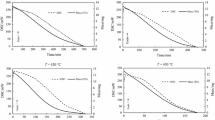Abstract
The rapid evaluation of the hazard of heat generation by oxidation of materials using a differential-type adiabatic calorimeter (DAC) was investigated, assessing oleic acid and polyethylene glycol samples of various masses. The same samples were analyzed using an accelerating rate calorimeter and a high-sensitivity calorimeter (C80), for comparison purposes. The kinetic parameters of the exothermic reactions were determined from the C80 data, and the associated exothermic behaviors of the samples were compared with those observed using the DAC. Oleic acid exhibited self-heating at lower temperatures compared with polyethylene glycol according to each measurement method. Thus, the comparative risk of heat generation of chemical materials by oxidation may be evaluated using a DAC. The DAC technique allows the prediction of exothermic behavior based on a single measurement performed over the course of a single day. Thus, the assessment of autoxidation exothermic behaviors using a DAC may be applied to allow rapid screening of the hazard of heat generation induced by oxidation of chemical substances.









Similar content being viewed by others
References
United Nations. Section 33 Classification procedures: test methods and criteria relating to class 4. In: Recommendations on the Transport of Dangerous Goods, Manual of Tests and Criteria, 5th ed. New York and Geneva: United Nations; 2009. p. 353–368.
Kotoyori T, Maruta M. An adiabatic self-ignition testing apparatus. Thermochim Acta. 1983;67:35–44.
Kotoyori T. Critical temperatures for the thermal explosion of chemicals. Amsterdam: Elsevier; 2005.
Li XR, Koseki H, Momota M. Evaluation of danger from fermentation-induced spontaneous ignition of wood chips. J Hazard Mater. 2006;135:15–20.
Lim WS, Iwata Y, Koseki H. Thermal characteristics of hydroxypropyl methyl cellulose. J Loss Prevent Proc. 2009;22:182–6.
Miyake A, Morioka K. Influence of metal oxides on the thermal ignition behavior of woody biomass cellulose. Sci Technol Energ Mater. 2011;72:123–6.
McIlroy K, Zawierucha R. The use of the accelerating rate calorimeter in oxygen compatibility testing. ASTM Spec Tech Publ. 1986;910:98–107.
Hirabae Y, Tanaka N, Ichimura K. Evaluation for spontaneous ignition using ARC. In: Proceedings of the annual meeting of Japan Society for Safety Engineering; 1990. p. 129–132 (in Japanese).
Sasada T, Ohizumi A, Okada O, Usui O, Miyake A, Ogawa T. Study on spontaneous ignition of leaked oil. In: Proceedings of the annual meeting of Japan Society for Safety Engineering; 2008. p. 39–40 (in Japanese).
Townsend DI, Tou JC. Thermal hazard evaluation by an accelerating rate calorimeter. Thermochim Acta. 1980;37:1–30.
Center for Chemical Process Safety. Accelerating rate calorimeter (ARC). In: Guidelines for chemical reactivity evaluation and application to process design. New York: Center for Chemical Process Safety of the American Institute of Chemical Engineers; 1995. p. 71–6.
Barton B, Rogers R. Characterizing the runaway reaction. In: Chemical reaction hazards, a guide of safety, 2nd edn. Rugby: Institution of Chemical Engineers; 1997. p. 40–5.
Huff JE. Emergency venting requirements. Plant/Oper Prog. 1982;1:211–29.
Huff JE. Emergency venting requirements for gassy reactions from closed-system tests. Plant/Oper Prog. 1984;3:50–9.
Kikuchi T. The use of the ARC to estimate safe handling and transportation temperatures. J Jpn Soc Saf Eng. 2001;40:100–7 (in Japanese).
Wu F. A new era of Φ ≡ 1 differential accelerating rate calorimetry. In: Proceedings of the Asia Pacific Symposium on Safety 2009 (APSS2009); 2009. p. 376–9.
Wako Pure Chemical Industries, Ltd., Safety Data Sheet, Polyethylene glycol 200, Version 1; 2013.
Wako Pure Chemical Industries, Ltd., Safety Data Sheet, Oleic acid, Version 1; 2013.
Litwinienko G. Autooxidation of unsaturated fatty acids and their esters. J Therm Anal Calorim. 2001;65:639–46.
Litwinienko G, Kasprzycka-Guttman T. Study on the autoxidation kinetics of fat components by differential scanning calorimetry. 2. Unsaturated fatty acids and their esters. Ind Eng Chem Res. 2000;39:13–7.
Mantzavinos D, Livingston AG, Hellenbrand R, Metcalfe IS. Wet air oxidation of polyethylene glycols; mechanisms, intermediates and implications for integrated chemical-biological wastewater treatment. Chem Eng Sci. 1996;51:4219–35.
Roduit B, Hartmann M, Folly P, Sarbach A, Brodard P, Baltensperger R. Determination of thermal hazard from DSC measurements. Investigation of self-accelerating decomposition temperature (SADT) of AIBN. J Therm Anal Calorim. 2014;117:1017–26.
Roduit B, Xia L, Folly P, Berger B, Mathieu J, Sarbach A, Andres H, Ramin M, Vogelsanger B, Spitzer D, Moulard H, Dilhan D. The simulation of the thermal behavior of energetic materials based on DSC and HFC signals. J Therm Anal Calorim. 2008;93:143–52.
Roduit B, Folly P, Berger B, Mathieu J, Sarbach A, Andres H, Ramin M, Vogelsanger B. Evaluating sadt by advanced kinetics-based simulation approach. J Therm Anal Calorim. 2008;93:153–61.
Roduit B, Dermaut W, Lunghi A, Folly P, Berger B, Sarbach A. Advanced kinetics-based simulation of time to maximum rate under adiabatic conditions. J Therm Anal Calorim. 2008;93:163–73.
Miyake A, Nomura K, Mizuta Y, Sumino M. Thermal decomposition analysis of organic peroxides using model-free simulation. J Therm Anal Calorim. 2008;92:407–11.
Iwata Y. Hazard evaluation for heat generation by oxidation of liquid chemical substances. In: Proceedings of the annual meeting of Japan Society for Safety Engineering; 2013. p. 41–2 (in Japanese).
Stoessel F. Autocatalytic reactions. In: Thermal safety of chemical processes, risk assessment and process design. Weinheim: WILEY-VCH; 2008. p. 311–34.
Acknowledgements
The author wishes to thank Dr. Haruhiko Itagaki and Dr. Yasuhiro Fujimoto of National Institute of Occupational Safety and Health, Japan, for providing valuable advice, as well as Mr. Sakira Kaneko of PalMetrics for providing the Advanced Kinetics and Technology Solutions Thermokinetics and Thermal Safety software.
Author information
Authors and Affiliations
Corresponding author
Additional information
The present article is based on the lecture presented at JCCTA50 conference in Osaka—Japan on 28–30 September, 2014.
Rights and permissions
About this article
Cite this article
Sato, Y. Evaluation of the hazard of heat generation by oxidation of materials using a differential-type adiabatic calorimeter. J Therm Anal Calorim 123, 1851–1859 (2016). https://doi.org/10.1007/s10973-015-4954-9
Received:
Accepted:
Published:
Issue Date:
DOI: https://doi.org/10.1007/s10973-015-4954-9




